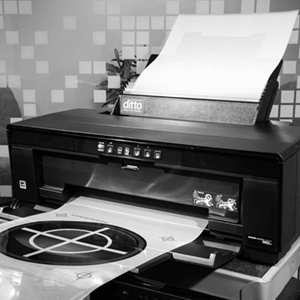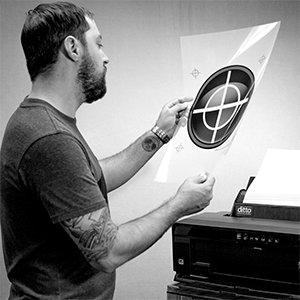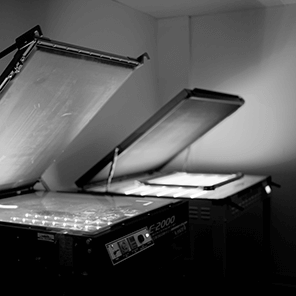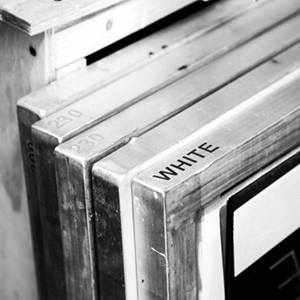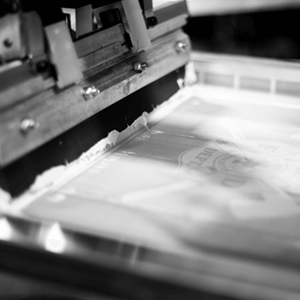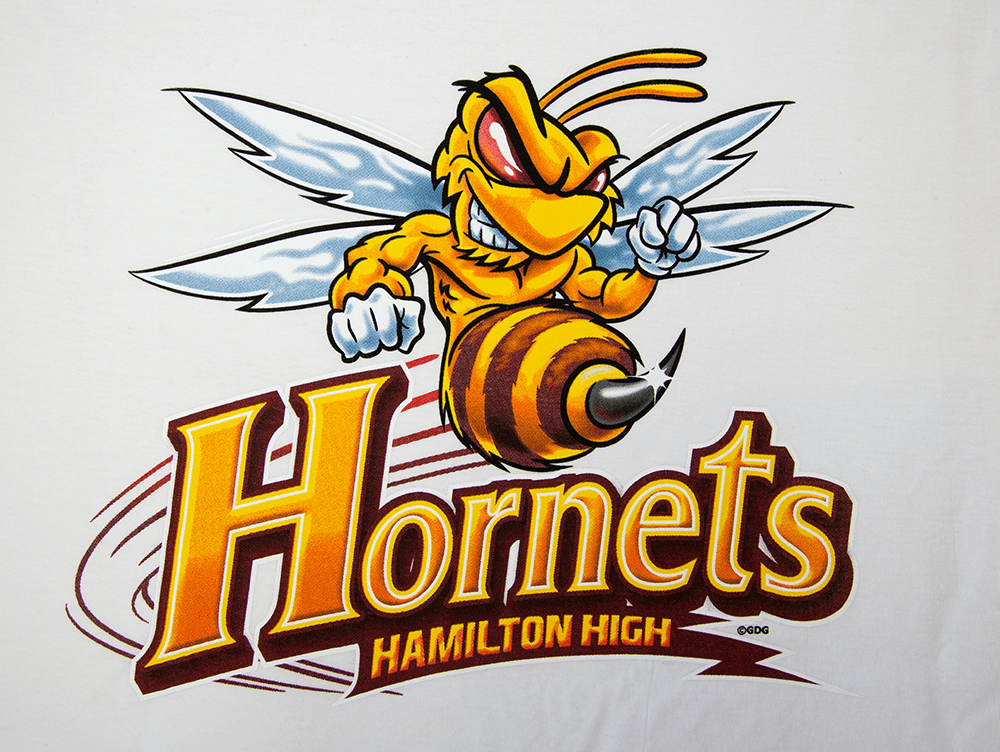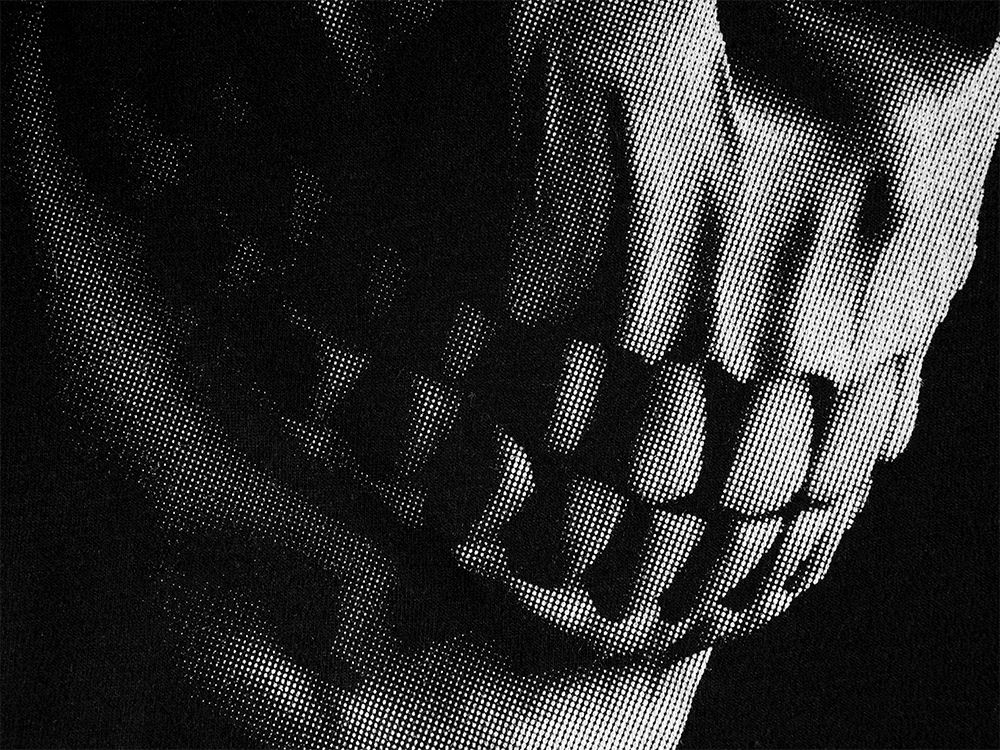Tips for Screen Printers
Freehand and You, Together We Got This
Blog posts (categories listed below). Freehand has forty plus successful years in the screen print industry. Get tips from the go-to resource the industry trusts for advice, best practices and solutions.
Inkjet Printers
Inkjet technology came into play for the screen-printer well over a decade ago. Over the years products engineered for screen-printers delivered the ability to achieve quality results with greater speed and reliability with the added benefit of more affordable hardware and consumable prices.
The software that drives inkjet technology is key. The RIP is where you control the settings for the printer such as resolution and ink flow. Your RIP software has a lot less to do with high density than most users understand. The physical link (marriage) between the film and ink is responsible for the achievement of dense films that will expose properly during the screen-exposure process. If you want to control the cost of making film positives and achieve great results work with the proper mix of products.
What is key for every screen-print company wishing to utilize inkjet technology for making films is selecting the proper hardware to meet the specific requirements of your shop. Consider format size and the amount of films you make per day on average. You can waste money purchasing a device with too large a format and price tag, or waste time using hardware with too small a format or without an auto roll device when you need to produce a lot of films daily. Every shop (large or small) should institute a back-up plan for those unexpected hardware issues or workflow interruptions. This goes for inkjet printers and not just computer hardware. We can’t stress this point enough, have a secondary printer such as a smaller desktop model. It is a scary proposition to constantly be under deadlines yet your company lacks back up hardware, supplies and personnel. I would hate to be your client when I can’t get my garments in time for my event because of poor planning on your part. If you are running on a tight budget then being organized and proactive is critical. I took my own advice decades ago when starting out as a screen-printer and it allowed our shop to grow and profit and keep my stress level low and my customer’s appreciation high.
At Freehand we support specific models for AccuRIP™ Software users. Why? Because not all models are good for what you are producing with an inkjet. These devices are engineered to be efficient color devices for outputting color images as composites. It is the screen-print industry that found favor with these devices for film output (black ink marrying to clear film acetate) and have worked to make the process as easy and productive for you. So, if we see two printers on the market that will deliver the same ability (within a format size), but one is more expensive and the extra price does not offer usable features then we don’t support the model. This is how we can help our users stay on budget without them even knowing what we did for them. We suggest you review a RIP Software’s supported inkjet list and then investigate the features of the device including price, plus the availability of the All Black Ink option for the model.
There are two styles, Dye and Pigment. Both make films and both need to be matched to a proper film supply (there is that focus on film again). Pigment and Dye are radically different inks so don’t choose the wrong film. Some claim there are films that work “great” for both – wrong! A film works “best” for the ink it was designed for and it works “okay” with the other. Buy the proper film for your inks and “test” them before you buy in bulk.
The industry standard is Dye ink:
Dye ink is available through many suppliers and works with lower cost films, which does not mean lesser quality films. Dye ink requires a thinner emulsion layer than pigment ink and the thicker emulsion layer is where the cost of manufacturing and purchasing film rises. Dye quality will vary. We formulated a dye that has the right properties for dye inkjet film media. A lesser quality dye will not allow you to achieve the higher density needed to hold all the details on the film so it translates to accurate screens and vibrant press prints.
Air dry technology:
Using dye ink means that you are utilizing an “air dry” technology. One of the reasons we like inkjets is that there is no “heat” involved in the process. A laser printer which uses heat can create registration problems. With inkjet technology the films are not shrinking due to intense heat. However that also means the ink is not “fusing” as fast. It takes a little time for the ink to dry to the touch and up to 24 hours to fully “cure”.
Dye ink is aqueous meaning it’s water based with dye and uv blocking agents to make up the density to block UV light in the exposure unit. Giving the film more time to cure before use means more water will evaporate leaving behind only the dye and UV agent. When the water is fully evaporated we call that “cured”. A cured film is not only greater in density, but it’s much more durable, scratch resistant and archival.
Dry ink is like pudding, it may be dry to the touch (on top), but below the surface it’s unstable and easily reactivated by moisture. Press a “dry” film up against a damp emulsion screen (not fully cured) then turning on a hot exposure lamp creates a greenhouse effect. Your film will likely fall apart after it’s first use. Yes, you can use inkjet films just produced if time does not allow for a total cure.
Plan ahead:
Films measured soon after printing will always have a lower density reading then those who were allowed to fully cure. A few hours is good, over night is best.
Yes, it is possible to run a screen print shop and make your films a day in advance. Yes, it involves making other parts of the prepress process more efficient, but it certainly can be done. By doing so you will always have the best films you can make. Better films make better screens and prints, improving your business quality. Strive to be the best you can be. Do things right as often as possible.
Printers use ink and ink runs out. Don’t just have one set of ink in the printer, have a backup set waiting. Epson and other printers setup their devices to have a zero tolerance when it comes to ink. Meaning if one cartridge is out then the printer stops working. You are going to use it to make money, so don’t be afraid to invest in stock as you do with all other items. Downtime caused because you ran out of ink is costly. There is no good reason for this to happen. Frankly, don’t be “penny wise and pound foolish”.
Color Inks make no sense.
You are a screen printer so you make films. Films use only black ink, so why do you have color ink in your printer? Oh yes, that was Epson’s idea because that is all they sell, but you have different needs.
Color inks that sit idle can, and most likely will, dry up and clog your inkjet. Why spend money on things that not only cost you money, don’t make you money, create downtime and cause clogs?
AccuRIP™ is the pioneer RIP for ALL BLACK printing. It’s the only RIP that makes sense for your job description.
Frankly, running ALL BLACK inks all the time is part of keeping your inkjet printer healthy and is a proper way to spend your money. Do what you will, but this is correct on so many levels. Stop using just any RIP, which cannot do this for you, and switch to AccuRIP™.
Epson and other printers setup their devices to have a “zero tolerance” when it comes to ink. Meaning if one ink is out, then the printer stops working. If one computer chip on a cartridge goes bad then the printer stops printing. If you get a new set of inks and one cartridge is damaged then the printer will not print.
Frankly, be smart; give yourself a fighting chance. Stock extra ink so you can swap cartridges if needed. This is easily avoided downtime. Time is money so don’t waste either! Request a refund or replacement later, but keep yourself working now.
Inkjet printers have become the standard for film output today. They work very well, but users are not taking enough time to fully understand them. Inkjet printers spray ink and if they are not used enough those nozzles will clog creating downtime. Prevent trouble, use them often and learn your printer utility software functions, like performing head cleans and nozzles checks.
There is confusion among buyers when deciding what kind of an inkjet to purchase. For the purpose of this discussion we are going to focus on the Epson line of printers. Inkjets share much of the same technology and abilities, so why are there so many different models to choose from and which is best for you? Lets break them into two categories, desktop models and wide format models.
Desktop printers are smaller and generally do not handle “roll” media although a few do come with a roll option that “may” work OK for paper, yet it usually fails to deliver the results needed when printing to heavier film media. If using a desktop model, it’s highly advised to print film “sheets”. With so many models to choose from and just as many features with each, owning the best desktop model for your purpose is easier than you think.
1. You’re a screen-printer using an inkjet printer to print black ink on film and not color. Remember that, because all the extra ink tanks with orange inks, gloss optimizers and choices of matte or photo blacks mean nothing to you so you don’t need to pay extra for them.
2. Desktop printers do not have a mechanical roll. They are more like a toilet paper roll holder (and just as useful) where the film is tugged through the printer creating wear and situations of “off-registration”. Not advised at all.
3. That brings us back to film sheets. Buy the printer that handles the biggest size you will use. Now they are all equal. The least expensive of the present shipping models is the 1430 and it handles up to 13 x 19 film, along with the other desktop models (up to the 3880). Why pay more than $700.00 for a printer when you can spend less than $250.00?
4. Shipping models as of May ’09 use Ultra Chrome K3 PIGMENT inks are great for archival prints on paper, but don’t work well with dye based films which are common in the industry. The “diamond in the rough”, or the Epson 1430, is the only Epson printer that ships with Dye and Dye is best for making film. All others printers can and should be converted to Dye to get the best results.
5. There has to be some difference between printers that matters to a screen-printer? In fact, the only other feature that matters is the size of the print head. The bigger the print head the more surface area that will print with each pass and that translates to faster printing and the difference basically stops at the R1900 model (no longer in production). My suggestion to anyone buying a desktop printer to make screen-print film positives is to consider the Epson 1430 and nothing more.
Why spend the extra money for a wide format printer such as the Epson 4900 or larger (approximately $1,700.00)? The simple answer is a mechanical roll and knife.
As for Wide Format Printers, starting with the older 4000 series printer, Epson handles the heavier media rolls of film. With its built in suction that not only holds the media flat and helps advance it smoothly a user finally can make good use of larger film sizes, but there is more to it.
1. Time is money, so Don’t waste either! With a larger printer feeding rolls of film that automatically “cut” after each sheet, you can finally do “unattended” film output of your separations. This is the biggest and most valuable difference between desktop and wide format printers. With a desktop printer you must send “one” color separation at a time to the printer and feed a single film otherwise films will stick together. That takes “time” away from a valuable employee.
USB, USB CABLES and PORT CONNECTIONS Ethernet vs. USB
USB and USB cables:
No longer than a 6 foot USB cable should be used. The longer the cable and/or “multiple connections” increase the risk for poor communication and failures. Frank Lee Speaking! Any time you can use Ethernet over USB you should.
USB (Universal Serial Bus) is a convenient technology but not a “strong technology”. Here are things to do to improve performance.
1. Use one cable and don’t patch cables together. Patched cords can cause fatal packet errors. This may cause files to fail to print or to skip when printing. Skips are caused when the USB drivers recover too slowly and the data stream is interrupted.
2. A 6 ft cable (or less) is best. Since USB is a low powered technology the signal strength drops off as it travels over a distance so the longer the cable the weaker the signal.
3. If you must run a long USB cable you may want to investigate a signal booster.
4. “A USB to Ethernet print server adapter” may be a good option for USB only printers that must be located a great distance away. The computer sends the print via TCP (Ethernet) to the print server adapter (hub) that converts the signal to USB at the end.
Ethernet vs. USB
USB is a bit easier to setup but if your printer offers you the ability to use Ethernet then it is highly advised to take the time to set it up. Transmitting and canceling print jobs is faster and more efficient than USB.
Epson offers an easy to use free utility called “Epson Net Config” which is located on your Epson installer CD or downloaded from the Epson website which makes this process very easy to manage. If you wish you, may also refer to the printer manual to configure the address from the front control panel of the printer.
Larger Epson printers such as the 4900, 3270, and 3170 now come with Ethernet on board but it is configured with odd IP addresses. You will want to lock in a “static” address (one that does not change) that conforms to your local network address range (192.168.0.XXX or 192.168.1.XXX or 10.1.1.XXX). Once you have the number set in the computer you simply use that number in the RIP setup and that allows printing to begin.
A Common User created issue:
USB is popular but in fact a slower technology, so interrupting the RIP process by pushing buttons on your printer, pulling the USB cable in the middle of a print, or turning off the printer are all bad ideas. As the transmission of the data discovers the interruption it will cause prints to go into a loop. That loop will try to complete the last instruction, creating a backlog of new prints to fail until the trouble is addressed.
Windows users can best stop a printer right from the Epson Stylus Print driver. Yes the Epson driver, after AccuRIP™ has converted the data to a proper format it passes the data to the Epson driver to be delivered to the printer.
Mac users can stop files from the AccuRIP™ to Epson print monitor window.
Wifi (Wireless Fidelity)
Wifi can be as strong a print system as ethernet given the right environment, a well working router, and less distance between the printer and local wifi router than ethernet. Metal buildings, florescent lighting, cellphone signals, cellphone towers, and more… are all items that could lower the reliability of wifi connections. Wifi can be tricky for some users to setup. Consult with your printer manufacturer for initial setup assistance.
Films
There are many styles of film even from one company. Each has different properties and different abilities. You get what you pay for. It costs a little more money to make better film, but the result is consistently better results. Always choose the best film possible because the film is what is brought to the screen-exposure device. Don’t forget, we are “screen” printers. If your screens are second rate then your prints will be too. There is just no other way to put it.
The emulsion layer on the film certainly helps speed the drying process and keep edge quality high reducing dot gain. Avoid using films with a thin, almost “clear” appearance and never use a “non water proof” film. Dye ink (recommended over Pigment) is water based so use a proper film. The name alone “non waterproof” should tip you off that it’s not the best product for your needs. The slightly cloudy emulsion of the film does not affect the exposure process but it grabs a hold of the ink sprayed onto the film during output.
SOLD OUT. The Ditto is no longer in production as printer body types have changed.
Freehand Graphics ditto film feeder, which is the ONLY solution to this timely issue in the industry. * With the roll and knife you can send many separations to the printer and do something else while they print. In a short time you will make up the difference in the cost of the printer. These printers have the largest print head so they print faster too a lot faster.
They also hold a huge amount of ink so that is another bonus as desktop printers with small ink tanks need a lot of attention and usually at the worst time. With both wide format and desktop printers see the All Black Cartridge Based Bulk Black Ink solution visit www.allblackbulkink.com page located on this website to dramatically increase black ink volume for selected models.
Rolls of film generally cost less per foot, rather than cut sheets. You can print more than one separation side by side to maximize the films usage, adding to its value. Check with your chosen film manufacturer.
All the newest Epson printers now come with Ethernet networking as a stock feature, making the printer more network friendly and efficient.
Now that you have read this you are educated to make and be satisfied with your purchase. If you are coming from a laser printer or a thermal unit to an inkjet for the first time there are things that you need to become comfortable with. Making a less expensive purchase of say a 1430 then deciding to go for the larger format printer such as a 4900 later may work well for you. Using AccuRIP™, you will not have to purchase a new RIP license to transfer to a new model while other RIP manufacturers would charge you.
Do I need to run my inkjet at the highest resolution?
No. For most screen-printers and their needs running an inkjet at 1440 x 720 will deliver quality results and acceptable print speeds. Inkjets work on a technology of multiple passes. The higher you set the resolution the more often the head will pass in close proximity to the previous pass, increasing the length of time for each print. That time can become quite lengthy. The object of every user is to test their inks and film against the lowest resolutions while still achieving the quality they desire.
The amount of time it takes you to get your films produced is extremely important. Slow processing over the course of the year will cost you an astronomical amount of time. Time is money, so don’t waste either!
Screen Printers work around water and it is highly advised to work with waterproof film. There are plenty of brands at great prices for waterproof film leaving little reason to use non-waterproof.
Frank Lee Speaking!
Waterproof film is not really waterproof it’s water-resistant. It’s not the fact that you are looking for films to be waterproof, it’s more that the emulsion coating on the films help the ink adhere better to the film. Faster drying times and less dot gain will be achieved resulting in properly accurate screens.
Ink would rather have something to grab onto. On non-waterproof film there is nothing for the ink to grab, it takes longer to air dry, and spreading occurs. that’s bad. Motto: Time is money! You think you are saving money on a slightly less expensive film but in fact your losing time waiting for it to dry and time is money.
Where did the fear/misunderstanding of Dot Gain come from?
Lack of education is the “hard” truth. Improper explanation by others is another reason.
Printers that claim to have come up with their own “special” and “secret” angles when printings to eliminate moiré are just flat out wrong. These Printers really printing a moiré anyway, just one they feel is “acceptable”. Now that you have this straight, forget it and we can all have a good laugh at ourselves.
The facts:
Modern day printing would not exist with out the “halftone”. This was the single greatest advancement in printing history so when someone tells you to avoid halftones I would just avoid that advise instead. Tonwertzuwachs is German for “Tone Value Increase” or in today’s term Dot Gain. Tonal Value Increase is not a good thing; it’s a great thing! Very needed to achieve advanced colors on press. Don’t avoid it – embrace it.
Simply put, “dot gain” has an undeserved stigma. While “Tone Value Increase” sounds so much better, but means the same thing.
Getting more colors from a limited set of colors is what printing is all about, and the reason these systems were invented as a replacement to Chromolithography used by such printers are Currier and Ives. Lets not go backward by thinking that indexing is at all comparable to halftone printing in any way. Printing in the Flemenco style accepts up to 40% press gain without the loss of detail or the corruption of color. The reason is that there is a lot more room between each spot (halftone) allowing for the “physical” gain of the ink that eventually increases tonality and color. With a Rosette pattern the space between each spot is greatly reduced due to the angle shifting. Since screen print presses are high saturation devices that top out around 33% Flemenco style printing never over gains allowing for very deep clean runs with little to no downtime. Rosette printing has trouble with as little as 15% dot gain. Presses have for along time been able to hold tight registration and printers of all fields should have converted back to Flemenco but they followed old thinking with out asking why? The proof that Flemenco is as proper today as it was back then is that, with today’s new high tech “digital” presses print using single angle (continuous) configurations and not rosettes. Mystery solved, pass it on.
Do things right and get better results. Stop using multiple angles and use only one angle (22.5 is advised) for all styles of printing. “Don’t run from what you don’t understand, learn it and advance.”
So many conversations surround this topic and the answers are just as confusing. Who to believe? Learn the facts then believe yourself.
Here it is. Once again Elliptical dots where invented to fight against the dot gain created by using a rosette pattern for CMYK. The close proximity of the spots left little room for proper dot gain causing an unwanted build up and merge of inks. Rather than use the tradition and proper round dot it was discovered that an Elliptical dot does not spread equally in all directions. This was helpful to combat dot gain issues, but it’s a “bandage” fix for using the improper method of four separate angles (a rosette pattern) for colors, rather than the proper “single angle” method called Flemenco.
So many printers struggle and there is no need for that. Bad advice spins them off into a loop of theories and patches. Trying to improve and prevent problems when the plain truth is by using a single angle for ALL colors reduces or eliminates most of the troubles while improving prints dramatically.
Frank Lee Speaking!
Believe what you will, but I can tell you that I have been screen printing for nearly three decades and I have not yet seen a “hole grab mesh”. This is the usual reason I hear people tell others they should use Elliptical dots. You burn your line screens to the emulsion layer and not the mesh, so why even discuss it. Elliptical dots work and you may use them, just know why and tell others so proper knowledge can be passed on. Print Elliptical if you wish, just be sure to use Flemenco (single angle) and produce better prints right away.
Rosette vs. Flemenco
Many still wish to challenge the fact that multiple angles are wrong and that single angle is proper. During discussions many will say it cannot be done and when asked why, they simply have no good answer other than someone they think was smart told them that. Ask to see their prints first and how hard they had to work for them.
The conversation usually turns to the “secret angles” they have discovered and usually its that they simply line up the black and yellow screen which improves clarity and reduces dot gain. I always say “great idea” but why stop there? You have only improved your print by 50%. If you can line up two out of four colors, and the world did not stop spinning, then why can’t you line up all four? Usually followed by silence and a lot of brow ruffling. Now it sinks in and they smile. This method is so correct that the very Italian newspaper that discovered it, Flemenco, patented it. The patent has never been challenged or enforced so feel free to use it.
It is flat out wrong to print using a rosette pattern (multiple angles) when you can use the Flemenco (single angle) style. Yes, all four screens should share “the same” angle and that angle is suggested to be 22.5 degrees. Choose any line screen you wish, but please note that 45 to 55 is now going to print much cleaner than any attempt at 65 line screen using a rosette pattern (multiple angles).
Inks are supposed to touch on press. When producing any style of tonal printing, the inks must touch in order to produce secondary and tertiary colors. it’s controlling the touch that makes us printers by profession. Those that Don’t are simply “spreading ink” and you Don’t want to do that.
Put two cans of finger paint in front of a child, one blue and one yellow and ask them to make green. They simply dip their finger in and mix the colors (secondary color) on the paper, done. No hesitations, its the right and only way to do it. So remind we why we adult printers are over thinking the process and spending all our money at seminars that are not teaching Flemenco?
Let the squeegee pressure miss the colors as they are applied to create new colors. The fear that it will make a mess and smudge comes from low screen tension, poor ink quality and incorrect press setup (squeegee and flood pressure) and nothing else. Single Angle Printing is the best way
This fantastic, clean and easy method of printing with a single angle for all screens is discussed in the Rosette vs. Flemenco Topic.
If halftones were confusing (not anymore) what about the angle used?
The angle of a halftone line screen has everything to do with the overall image clarity and the technical avoidance of moiré. Moiré is an undesirable repeating pattern that develops when two halftone angles interface in conflict.
When the angle at which you setup a halftone line screen is wrong it will create a moiré with your mesh. This is a major concern for us Screen Printers but it’s also something that is easy avoid.
The best halftone angle for humans to see a printed halftone is 45 degrees. Technically best, but as Screen Printers we cannot use this angle. This is the angle used as often as possible when printing images using offset or digitally. There is no concern with moiré because paper and plates have no angle of their own like our stretched mesh.
Proper mesh is stretched onto a frame at 90 degrees giving it an angle all its own. Adding to that a conflicting angle from your halftone line screen film will develop an instant moiré.
So just pick another angle right? Right and wrong. There are many angles that will be in conflict with your mesh and others that do not moiré but deliver a less than desirable visual result. Again, a concern but something really easy to understand and avoid. This article will teach you all you need to know.
One goal is to use a halftone line screen and angle that not only does not moiré with the mesh, another and the most important goal is to have the best looking print possible.
There are some debates and opinions over what angle is best but, technically and most importantly, visually 22.5 degrees being half of 45° and closer to horizontal than vertical is the best angle to choose for all your halftone work. Use the same angle for all colors when printing one color, multi-color, and even CMYK prints.
As the angle of halftones lay down closer to 0° (less and 45 degrees) on a protractor, they blend more easily with the optics of the human eye. Halftones that are tight or more vertical than 45 degrees such as 61 degrees or 75 degrees will also reduce or eliminate moiré but deliver a more visual frequency within the finished print. After all, we want to look at the overall print and enjoy it, not see the technical line screen values that produced it.
Bottom line, in the screen print industry use the angle of 22.5 degrees for all your screens and halftones regardless of the “style” of printing you are doing. Tonal single color, multi-color, Spot Process™ Sim Process, and CMYK. All screens should share the same angle and all angles should be 22.5 degrees.
One angle for all your needs. Now you know.
Simple and totally correct.
Here are 3 example of tonal prints using super low line screens up to 55 line screen. All are impressive. Halftones not only reproduce images with high clarity they can also produce Style.
Exposing Screens
There are multiple light source units and single point light sources. Obviously, single point light sources control the light better and it is recommended to be used for a more detailed film exposure. Multiple units scatter light, attacking the films from multiple angles creating “undercutting” that reduce the screens accuracy. Both work, single source works better.
Exposure Unit Vacuum:
A tight seal between the screen, film and the exposure unit glass it critical to prevent “under-cutting”. Under-cutting is when light creeps around the dark areas of the film positive and exposes the emulsion beneath it to light. Frankly, that is a complete failure to the system. Keep your blankets in great shape and achieve the best seal possible.
Screens
We are screen-printers so screens are the most important part of the process. A poorly made screen means bad printing and “production down-time”. Screen-printers buy everything they say they need, but many do not own a proper screen drying cabinet, making their own devices which frankly speaking are “junk”, creating more trouble than they are worth.
Here it is, when drying a screen you must dry the screen with the “print side” facing the floor and the “squeegee side” facing the ceiling. Exactly as it is when you print with it. Reason: Gravity forces the emulsion to the proper side (print side) leaving the heaviest layer on the proper side of the mesh. This improves screen making, reduces exposure time, increases the stencil well which leads to better ink coverage, etc..
Stop making this early mistake. Get a proper screen drying cabinet or modify your setup to allow screens to be dried in the proper position.
Fact: the mesh layer between the emulsion layers slow down light waves and restricts their ability to expose emulsion, so an improperly dried screen that has the heaviest emulsion layer on the wrong side (squeegee side) will not capture detail or wash out properly. The first sign of this problem is the need to increase exposure time and the loss of fine detail; not to mention under-exposed (slimy) emulsion that washes down the drain. Sound familiar?
Many questions are asked about the method and amount of passes when applying emulsion. Frankly, do what you need to do to get an even smooth coating making sure your last “cleaning” pass is made on the “squeegee side” forcing the heavier coating to the “print side” as discussed previously under “Screen Drying”.
Fact: Capillary emulsion films are applied to the “print side” of a screen because that is the proper side to have the heaviest layer of emulsion on for reasons of proper exposure and printing. You need to achieve the same result using direct emulsions. Humidity and De-humidifier during screen making
Humidity is not a good thing. The idea is to remove water from the process not to introduce more. If it has never been explained before then let me tell you, most “de-humidifiers” don’t work, in fact, most introduce “more” humidity than they remove.
The small de-humidifiers that you buy at the local appliance store have such small fan motors that are over worked and they heat up. That heat causes the coil on the back of the unit to sweat. That sweat drips into the pan that you empty every day. Put your hand to the unit and tell me if you feel warm or cool air blowing out the back?
Seriously, do you think there is that much water in the air? If so we’d be fish and not printers.
Costing only a few hundred dollars more, large capable industrial disaster recovery style de-humidifiers work well. Rather then the alternative units, this is a good way to not only spend your money wisely but to get a proper job done. These units run cool to the touch meaning that the water they collect “is from the air”. Many have their own internal pumps as well.
I personally use an Oasis brand de-humidifier capable of pulling 6 gallons of atmospheric moisture in a 24-hour period of time. Used mainly for flood recovery, it is ideal for keeping the screen making room “dry”! If I collect 3 gallons of water from June to September that is a lot and it gets humid around here in July and August.
Color mesh reduces the amount of light that bounces around during exposure, which is most important when exposing films with fine halftone spots. I recommend the use of colored mesh such as yellow.
The tighter your screens are, the brighter your prints will be. The tighter your screens are, the less squeegee pressure is required to print properly. How much pressure do you think it takes to push ink through a screen anyway?
Tight screens improve registration by reducing or preventing “screen roll”. Screen roll is the pressure wave of mesh that rolls up in front of the squeegee much like a wave in the ocean. Tight screens allow more ink to sit “on top” of the garment where it belongs rather than being smashed through the weave down to the platen (which helps fend off sublimation in more ways than one), reduces the need for massive squeegee pressure (which most printers apply), and finally lets you set your squeegee angle at the proper upright position of 65 to 75 degrees. The proper squeegee angle allows you to efficiently use the business end of the blade (the edge).
Frankly, using less expensive frames that do not achieve higher tensions (over 25 newtons) are costing you money, not saving it.
“Time is money, so don’t waste either”.
Roller frames grant you greater control and the ability to re-tension. Aluminum frames are good and they hold tension until the mesh stretches. Eventually it will stretch and require a stripping and re-gluing process. Wood frames absorb water and solvents, therefore they do not offer the correct ability and have the shortest useful lifespan. Roller frames are best.
Halftone to mesh moiré demystified
Controlling halftones to avoid moiré is not luck it’s a skill, actually a formula and it’s easy to learn and master.
It’s all in the math and easy math at that.
There are many different styles of mesh in our industry. Some are monofilament while others are twisted braided just like fishing line. It’s the construction of the mesh that develops its ability to handle halftones and angles differently. Mesh manufacturers do the math for you. They understand what their products can do and deliver that information on their website and literature. It is best to first find out from the manufacturer or knowledgeable reseller what factor you should use with the simple math formulas that follow.
Some manufacturers use a factor of 3, 4, or 5. The most common factor is 5. Consult with your mesh manufacturer or supplier. If unsure try 5 first.
When using pre-stretched frames work the formula this way, Mesh count divided by factor (3, 4, or 5) to determine maximum line screen a mesh can accept without producing a moiré. 230/5=46. This means the maximum line screen halftone to be applied to this mesh should be 46 or lower. Simple.
For users that like to determine best line screen for an image then determine the proper mesh work the formula like this, 45×5=225. Choose that mesh count or the closest higher mesh, never lower. Also simple.
A properly stretched mesh over frame will be at a 90 degree angle making 22.5 degrees for all halftones the best angle to avoid mesh moiré as well produce a visually pleasing print. Learn more about the proper halftone angle by watching the video “ What’s your Angle? ”.
Knowledge is power. Be Powerful.
Press
Squeegees have many shapes and sizes. They are all designed to “sheer” the ink from the mesh and transfer the ink to the garment. I’m not going to get too deep here as there is so much to cover and the manufacturers will send me tons of letters defending each size, shape, durometer, etc.
I use 70 durometer square edge squeegees with 2″ or less of blade extending from the housing. Set at angles between 75 degrees and 65 degrees, this does the job perfectly for textile printing. Proper screen tension (tight) and proper squeegee pressure does the job of “sheering” the ink. Do what you will, but this is how I would set up your press if I were at your place.
Take a look at high-end squeegees such as the “constant force squeegee”. Its blade is so small and it’s angled at 65 degrees (close to it). Clamped into the printer at 90 degrees and the rubber is auto set to the proper print angle. Yes, I know it takes a very level platen to take advantage of this great idea (not all can), but hey, right is right. If we can’t create a perfect environment now, at least we know what we are shooting for. Strive for it in every way you can, but take from this information as it is intended. That crazy shaped housing is focusing the pressure down the tip of the blade where it belongs.
Frankly, the next time you see your blades doing the “limbo” on press back off the pressure, as you are not helping yourself.
Flood Bars and Flood Strokes
Many know that the flood bar on an automatic press along with the flood stroke move the ink into position for the squeegee but many do not fully understand the more important task. Yes, the flood bar spreads ink along the length of the screen, but it also forces the ink into the mesh and “stencil well”. The Stencil Well is the thickness of the emulsion layer on the “print side” of the screen that holds the ink until the squeegee “sheers” that connection and transfers the ink to the garment. Remember our conversation about “proper screen drying”? Now you are putting that to work. This is why only a small amount of squeegee pressure is actually needed. You want as much ink as possible to be left behind on the garment and not scooped back up by the squeegee. You need to know this if you want to be a good Screen Printer. This is how Screen Printing is done. Now you know more than you did before about “high-density” printing. Funny how all this stuff is connected.
Too much has been made of this over the decades and so many printers have struggled with poor results and even worse advice. There are a few factors to be addressed but they are all easy to do and their impact on your result will be dramatic. Basically all those things you fear about CMYK, or the reasons you sit in on seminars while speakers try to impress and confuse you all in the same breath, will fly right out the window.
It is flat out wrong to print using a rosette pattern (multiple angles) when you can use the Flemenco (single angle) style. Yes, all four screens should share “the same” angle and that angle is suggested to be 22.5 degrees. Choose any line screen you wish, but please note that 45 to 55 is now going to print much cleaner than any attempt at 65 line screen using a rosette pattern (multiple angles). Even before you learn a few more things to help you, if you do nothing more than simply use one angle and re-print one of your past CMYK jobs you will see a huge improvement!
If I walk into another shop and hear the “ripping and popping” of screen lifting off the garments or tacky platens on press, I’m going to scream. We have all seen the slow motion picture of a drop of milk spreading little droplets in all directions; well ink does the same thing. It spatters when torn off the garment at high speeds. If your screen does not gently pull away from your print after the squeegee has passed over an area leaving the screen and the garment separated by the end of the print stroke then you do not have enough off contact. If you need more than a slight amount then you need tighter screens.
The tighter your screen tension is, the cleaner and brighter your prints will be. Use tight screens.
When inkjet films are sticking to the emulsion and their peeling off. How can you prevent this? First identify why it is happening and then you can make the moves to correct it.
Inkjet printers are “non photographic” processes, unlike the old days of stat cameras, imagesetters and even thermal devices. Inkjets produce films by spraying ink to a surface layer and adhering to that surface. The process is far less durable and requires a little extra handling and understanding and it will result in a film that offer repeatable use.
As with anything there is a right and wrong way to handle a situation. When we used stat cameras and imagesetters, we had to develop, then fix the films and finally dry them before use. When printing t-shirts you know the difference between dried ink and cured ink. Cured is durable, dried is not. Well, inkjet inks are the same except they are air-dried and not force dried (cured). Just like pudding, inks first get a top skin layer that seems dry to the touch, but below the surface it is still unstable. Only when the water in the ink has evaporated and only the dye residue is left behind, can it be considered “cured”. This is why it’s so important to test your prints, making sure you are not over applying ink onto your film and that the film you are using is correct for the style ink you are using (dye vs. pigment). This match is critical to your success. On that note, not all films are created equal, and some release their emulsion layer to the screens emulsion taking the ink with it. If you feel this is the case, then test another brand.
When the proper amount of ink is applied to the proper film it dries rapidly. Films should come out of a printer dry to the touch and after an hour or two they should be “fully cured”. If you can get on top of your work schedule and print films a day in advance they will not only be more durable but denser as well. That is right, they will be darker. Density rises as the water in your dye based ink evaporates leaving behind only the dye.
Here’s the why:
Water and moisture reactivate water-based components. Add some heat and pressure and you have the making for a mini disaster. Your emulsion has water in it and so does your ink. Lets say you print a film and rush it to expose a screen (never happens I know, but humor me here), lets also assume you coated your screens about an hour ago on a humid day or in the same room you wash out your screens in (again, that never happens, right?).
The emulsion on the screen is still damp, the film is not fully cured, and you press them together in the vacuum table and flip on some HOT lamps. Bam! You will expose the screen, but there is a very small chance the film will survive this process.

